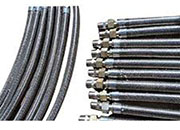Tips For Choosing a Compressed Air Hose
2022-08-15 09:07:41
A compressed air hose is a flexible tube used to transport compressed air. It is typically made from reinforced synthetic rubber that is resistant to weathering or ozone. It can withstand temperatures of up to 158degF. It features 1/2 NPT male brass fittings and is available in various lengths. You can buy it in lengths of 10', 20', 30', 40', and 50'. The length in feet is indicated by the dashed length.
Compressed Air Hose
There are many types of compressed airhoses available, each with their own characteristics. Choose the type that meets the requirements of your industry and needs. A hose should be resistant to oils, weathering, ozone and oils. It should also be flexible and non-toxic. Below are some tips to help you choose the best air hose for your application. To get started, you can check out our list of the top brands of compressed air hoses.
The types of air hoses vary in their flexibility and strength. There are two main types: standard and recoil. Recoil hoses are typically smaller and easier to store. Standard air hoses are most common in paint applications, but recoil hoses may limit mobility and interfere with other processes. To minimize air loss, choose a high-quality, reliable air hose with fittings. Flexible materials are also available to reduce the risk of ruptures.
The Material of the Compressed Air Hose
You should consider the material used to make your compressed air hose. The material it is made of will affect its flexibility, weight, and performance. In addition, you'll need to choose a material that can withstand the working environment it is in. Cold climates can cause hose materials to be damaged, so the fluids that are used must be compatible. Petroleum products and food processing are two examples of industries where material compatibility is important.
It is important to select a material that is resistant against a variety chemical reactions when choosing a compressed airhose. The chemical properties of different gases affect the hose's material, and certain types won't work with others. PVC and rubber are two common materials, but neither are particularly resistant to environmental factors. If the environment is harsh, you may want to consider silicone or EPDM.